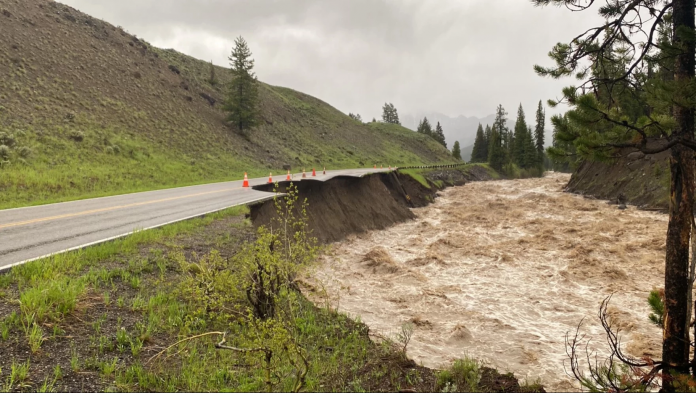An article in the Billings Gazette claims that severe flooding in Yellowstone National Park will become more common and frequent due to climate change. This claim is false. Data does not show any increase in flood events amid modest warming. The atmospheric river event this spring was not unprecedented, and weather events themselves cannot be proof of climate change.
The article, “The Yellowstone flood was a historic disaster. Climate change means it won’t be the last,” written by Casper-Star Tribune reporter Nicole Pollack, propagates unsubstantiated claims from climate alarmists. She neglects to mention any of the conflicting data.
Pollack says the odds of having an extreme flooding event are higher today than they ever have been. She quotes several scientists who repeat the same idea, that climate change makes “bigger, faster” floods more likely than before. Besides this being an unfalsifiable and untestable claim, it also conflicts with what the United Nations Intergovernmental Panel on Climate Change (IPCC) says about flooding.
Climate at a Glance: Floods points out that the IPCC says there is only “low confidence” that there is even a “sign” of change to the frequency or severity of flooding. It has “low confidence” that climate change impacts flooding at all. Some regions of the world have seen more flooding, others less, it cannot be attributed to global climate trends.
A study looking at flooding in the U.S. and Europe in the Journal of Hydrology says that “The number of significant [flooding] trends was about the number expected due to chance alone.”
Despite population growth in areas near water sources like rivers and lakes, the cost of flooding the U.S. as a proportion of GDP has gone down over time. (See Figure 1 below)

Two events coincided to create this June’s Yellowstone flooding: the heavy rain due to an atmospheric river event, and preexisting late-season snowpack. Since global warming is supposed to reduce springtime snow extent, it can’t be blamed for the latter.
As for the former; atmospheric river events, as explained by meteorologist Anthony Watts in a Climate Realism post, “Science Demonstrates Media Claims the Washington and British Columbia Floods Were Caused by ‘Climate Change’ Is False,” are not always caused by warming, either. Such was the case with flooding in British Columbia during the fall of 2021, where weather was cool to normal along the path of the atmospheric river. The same can be said for Yellowstone—a cool spring was present when the river formed. These are localized weather events, not climate, which is an average of weather over a 30-year period.
Also notable is that most of the flooding caused by this most recent atmospheric river was in Montana, where the precipitation trend has been relatively stable since 1900, according to data from the National Oceanic and Atmospheric Administration. The same dataset shows that the state record for highest annual precipitation is still held by the year 1927.
Every time an interesting or record-breaking weather event happens, the media and alarmists flock to attribute it to climate change, regardless of what the long-term data show. As opposed to educating the public, all this kind of coverage does is confuse and frighten people. The goal is likely to scare people so badly, they will end up supporting government policies that are supposed to somehow stop bad weather from happening. Climate alarmism can only exist where real data is ignored or hidden. In this case, data on flooding simply does not back up the story.


















